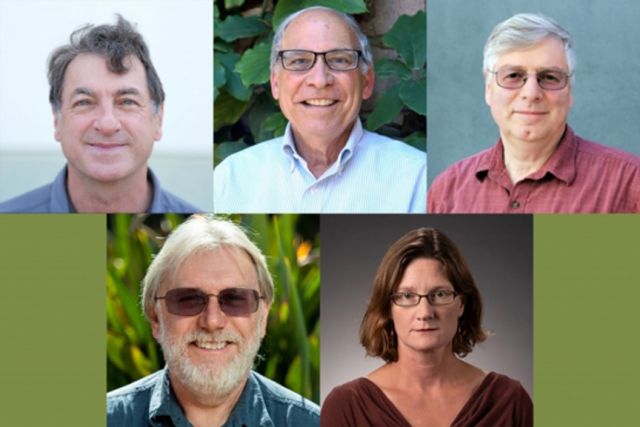‘Truly Impactful’ Research
Five UC Santa Barbara professors have been elected to the American Association for the Advancement of Science

By Sonia Fernandez
Tuesday, January 31, 2023 - 10:00
Santa Barbara, CA
Climate sensing. Neural circuits. Active matter. Molecular beam epitaxy. Multimedia learning. Five UC Santa Barbara professors in disciplines spanning geology to biology, physics to psychology have been selected as this year’s newest fellows of the American Association for the Advancement of Science (AAAS).
The new fellows are: geography professor Dar Roberts; biology professor Julie Simpson; physics theorist Mark Bowick; materials scientist Chris Palmstrøm; and Richard Mayer, a professor of psychological and brain sciences. Election as an AAAS Fellow is an honor bestowed upon AAAS members by their peers for their scientifically or socially distinguished efforts to advance science or its applications.
“I extend hearty congratulations to professors Roberts, Simpson, Bowick and Mayer,” said Pierre Wiltzius, the Susan and Bruce Worster Dean of Science, and a professor of physics. “This accolade recognizes their highly valued scientific innovations and contributions to original research. I am so proud that they are members of our esteemed UC Santa Barbara faculty.”
“Congratulations to Professor Chris Palmstrøm on his election to the prestigious American Association for the Advancement of Science, one of the pinnacles of the profession. His indispensable expertise in using molecular beam epitaxy to control the growth and the interface structure and chemistry of dissimilar materials has led to the creation of many novel materials having new and useful properties,” said Tresa Pollock, interim dean of the UCSB College of Engineering. “It is wonderful to see Chris be recognized for contributions that are important because they are truly impactful.”
“Over my academic career I have been fortunate to have had the opportunity to benefit from incredible advances in remote sensing technology and applications, and the opportunity to have contributed significantly advances in its use for ecology, land use, wildfire and atmospheric and remote sensing,” said Dar Roberts(link is external), who specializes in deploying active and passive remote sensing systems to monitor the climate and its changes. “My contributions could not have been possible without the assistance of numerous colleagues and the graduate students I have mentored; I am honored to be recognized by the AAAS as a fellow.”
Julie Simpson(link is external), meanwhile, dives deep into the mystery of how neural signals are translated into physical behaviors. Using fruit flies as her model organism of choice, she studies how the tiny animals organize and prioritize stimuli into precise motor behaviors and responses in an effort to gain insight into universal mechanisms for ordered execution of competing behaviors.
“It is wonderful to have the value of my work recognized by my peers,” she said. “I thank my lab members and colleagues at UCSB, at the Janelia campus at Howard Hughes Medical Research Institute and in the neuroscience and genetics communities who make this research possible and enjoyable to do.”
A visiting distinguished professor of physics at UC Santa Barbara, and deputy director of the campus’s Kavli Institute for Theoretical Physics, Mark Bowick(link is external) investigates the physics of soft and active matter. It’s a field that encompasses physical systems that can be structurally altered by thermal and/or mechanical stress and generates counter-intuitive phenomena that in many cases have yet to be observed or fully characterized.
“The wide applicability of physical phenomena continues to surprise me,” Bowick said. “It is a pleasure to work in this field where theorists are actively collaborating on workable time scales.”
“Integration of materials with different properties, such as semiconducting, superconducting and magnetic capabilities, allow the creation of designer materials and structures with novel functions and applications such as in quantum computing,” said Christopher Palmstrøm(link is external), Distinguished Professor in the electrical and computer engineering and in the materials departments at UCSB’s College of Engineering. With his expertise in molecular beam epitaxy, a method of “growing” materials in a highly controlled, atom-by-atom manner, his lab generates novel materials for making new, specialized and next-generation devices.
How can we design instruction in ways that learners can take what they learned and apply it to new situations? That question is one of the main themes of professor Richard Mayer’s(link is external) research. A distinguished professor of psychology, his research delves into how people learn, and how to help people learn, with an emphasis on technology that includes multimedia, computer-supported environments and digital games. “My research focus is on applying the science of learning to education,” Mayer said.
The new fellows will receive a certificate and a gold and blue rosette pin to commemorate their election and will be celebrated in Washington, D.C. in the summer. They will also be featured in the AAAS News & Notes section of Science in February 2023.